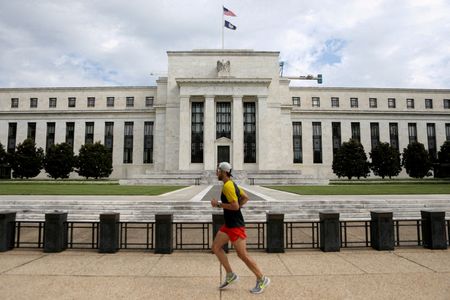By Michael S. Derby and Dan Burns
WASHINGTON (Reuters) – The Federal Reserve appears to be very much on track for an interest rate cut in September after a “vast majority” of officials said such an action was likely, according to the minutes of the U.S. central bank’s July 30-31 meeting.
The minutes, which were released on Wednesday, even showed some policymakers would have been willing to reduce borrowing costs at last month’s gathering.
The policy-setting Federal Open Market Committee left its benchmark interest rate unchanged in the 5.25%-5.50% range on July 31, but opened the door to a cut at the Sept. 17-18 meeting.
Financial markets have been expecting the September meeting to kick off the Fed’s policy easing, with as much as a full percentage point worth of rate cuts expected by the end of this year.
At the July meeting, most policymakers thought that “if the data continued to come in about as expected, it would likely be appropriate to ease policy at the next meeting,” the minutes said.
They also noted “many” Fed officials viewed the stance of rates to be restrictive and “a few participants” contended that amid an ongoing cooling in inflationary pressures, no change in rates would mean that monetary policy would increase the drag on economic activity.
While all Fed officials were on board with keeping rates steady in July, the minutes revealed that “several” policymakers said progress in lowering inflation amid a rise in joblessness “had provided a plausible case” for a quarter-percentage-point cut in July, “or that they could have supported such a decision” had it been on the table.
The minutes also showed that a dwindling camp of policymakers feared a premature easing in monetary policy could restart inflation.
Jamie Cox, managing partner at Harris Financial Group, said “the Fed minutes removed all doubt about a September rate cut.” He added that “the Fed’s communication strategy is to make its meetings less of a market-moving event, and they are following the script to the letter.”
With the Fed letting the data determine what happens with rates, central bank watchers are already contemplating the future scope of cuts and whether aggressive action is needed at the onset of the easing cycle.
“It may not be too heavy a lift for (Fed) Chair (Jerome) Powell to move the Committee now to a baseline of three 25-basis-point cuts in a row” through the end of the year, analysts at Evercore ISI said. They added that there’s a “reasonably low bar” for half-percentage-point cuts, but that would likely require a “more pronounced weakening” in the job market relative to the softness seen in hiring data in July.
BALANCE OF RISKS
The case for cutting rates rests on the ebbing of price pressures back to the central bank’s 2% target and increased anxiety about the state of the job market in the wake of recent data showing a rise in the unemployment rate.
The speed of the jump in the jobless rate, which bottomed at 3.4% early last year and has since climbed to 4.3% as of last month, has added urgency to the debate over rate cuts and has prompted some analysts to say that a half-percentage-point reduction in borrowing costs should be considered next month.
The minutes noted that officials see the job market as having largely returned to where it was before the COVID-19 pandemic started, and described the job market as “strong but not overheated.”
Markets showed little reaction to the release of the minutes, with stocks rising modestly to end the day higher and bond yields falling. Fed funds futures showed the probability of a quarter-percentage-point cut at the September meeting falling slightly from Tuesday and the odds of a half-percentage-point reduction edging higher.
Powell largely tipped off the likely outlook after the July policy meeting when he said “if we do get the data that we … hope we get, then a reduction in our policy rate could be on the table at the September meeting.”
The Fed’s concerns about the job market may be underpinned by the Labor Department’s estimate on Wednesday that 818,000 fewer payroll jobs existed in March than previously reported. The change was part of the annual benchmark revision process.
Those revisions may not have caught Fed officials off guard, with the minutes noting “reported payroll gains might be overstated,” which means the economy might not need to add as many new positions each month to keep the jobless rate steady.
The minutes also noted that a “majority” of Fed officials saw risks to the job market as having increased while risks to the inflation mandate had been reduced.
The current level of joblessness is already higher than the 4% level Fed officials penciled in for this year in their updated economic projections in June, and the 4.2% policymakers projected for the end of next year.
Markets are likely to get an update of Powell’s views on Friday when he speaks at the Kansas City Fed’s annual research conference in Jackson Hole, Wyoming. A number of other Fed officials are also likely to weigh in on the outlook while attending the conference.
Another major point for the monetary policy outlook comes in early September with the U.S. Labor Department’s release of the employment report for August.
(Reporting by Michael S. Derby; Additional reporting by Lindsay Dunsmuir and Howard Schneider; Editing by Paul Simao)





